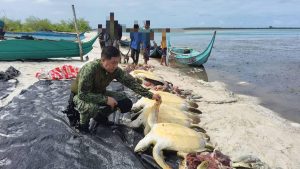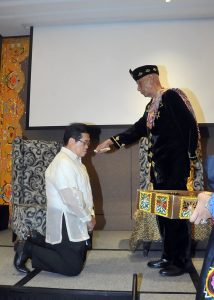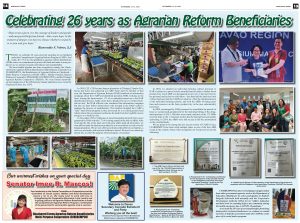THE AMERICAN Heritage Dictionary defines Dyscalculia as the “impairment of the ability to understand and solve mathematical problems.” Psychiatrists use the same word to describe the inability to “grasp what numbers mean in real life”. A majority of people today are afflicted with this inability, especially when it comes to numbers related to COViD 19.
While the word describes a brain function (or lack thereof), the best way to discuss the Davao City and Region 11 COViD 19 numbers after all these months is to describe the calculations in a language most of us understand.
Whatever our thoughts on numbers and how to make sense of them, our interviews with scientists and mathematicians throughout the year indicated that they agree on one thing – the community quarantine and extended community quarantine should have been longer, and far less people would have been infected by the virus.
The mathematical models explaining the numbers related to COViD 19 infections vary. Each model explains the specific behavior of COViD 19 infections, allowing public health decision makers to anticipate the movement of viral infections through the community, and the factors that allow the virus to move from one place to another through each infected person.
There’s the standard SIR model, which takes into account the Susceptible, Infected, and Recovered individuals (thus SIR). Essentially, the model groups people into three variables – S, I & R. Another one, the SIRD, adds the Dead element, and adds another layer to the formula.
Mathematicians from the University of the Philippines Mindanao (UPMin) here in Davao City lean towards using the SEIR model, which factors in the Susceptible, Exposed, Infectious, and Recovered – which is a third model encountered by the writer.
Essentially, according to notes from Stanford University, this third model considers elements such as effective contact rate, “birth rate” of susceptibles, mortality rate, progression rate from exposed to infected, and finally, the removal rate.
Dr. May Anne Mata is a Davao-based biomathematician leading a team of scientists at UP Mindanao’s College of Science and Math. In models as early as March 2020, several studies predicted that the pandemic could be over as early as July, with October and December showing the earliest signs of a downtrend.
For most of the year, Mata’s day-to-day operations at the Interdisciplinary Applied Modeling (IAM) Laboratory at UPMin, have included simulations of different pandemic scenarios. Her specialty, biomathematics, literally saturates her into this very real-world scenario.
For the very first time in a long time, students and faculty were discussing theoretical Xs and Ys that had real world implications, therefore facing questions that could spell life and death for health services front liners and their patients.
The foremost question in their modeling was “What was the best scenario in which front liners – doctors and related health services personnel – could still carry on with their tasks with the whole weight of Davao City’s health situation on their shoulders – while facing the least risk to their healths?”
In study notes released in UP’s websites as early as April 2020, Mata and a few others wrote that the pandemic was meant to be over as early as July if the city had extended at least another two weeks into the community quarantine. This, complemented by aggressive testing of individuals in areas and sectors likely susceptible to the disease.
The study, straightforwardly titled “Davao City should consider extending community quarantine beyond April 19 and conduct more tests for COVID-19”, UP Mindanao Researchers’ said an extension of the lockdown for at least two weeks would end the pandemic here, as early as July, granted the conditions continued after the initial two-week lockdown.
In her own study notes, Mata said that given a population of Davao City of around 1.7 million, based on latest statistics figures, the number of “susceptible individuals” would largely be dependent how many people are allowed outside. In effect, the infected individuals would also drop. In the community quarantine scenario, the strictest of quarantines, the numbers would have decreased as early as May; in slightly relaxed conditions, the number of cases stabilized as early as July.
The number of susceptibles in the community quarantine scenario was cut by half, Mata said, and this would have dropped further with the extended community quarantine, as shown in their modeling. Susceptibles include health front liners and people who need to go outdoors to get food and other essential items for day to day living.
Scientists working on the modelling also considered other assumptions. For example, a study places latency and incubation to be 3 days and 7 days, respectively. Another range is 16 days, a period which scientists note as a crucial period for unreported infectious persons who either die or recover.
This was based on March data from the Southern Philippines Medical Center. There are also additional factors such as infectious populations that are either unreported or confirmed. Put together the 16 day incubation period and the unreported infected population; these elements combine to form the hieroglyphics of symbols that data mathematicians and scientists work with every day.
You would think that these figures were enough to help policymakers, but policymakers and agencies themselves end up contributing to the confusion when they get afflicted with dyscalculia.
One would think that the data that’s crunched in this life-and-death model comes with direct coordination between the region’s Department of Health. It is not. The IAM Lab manually inputs the figures based on daily figures released by the agency. Until later in 2020, there was no direct correspondence between these agencies despite both coming from government. According to Mata, UPMin kept reaching out.
Among reporters and news agencies, it is widely known how confusing the data was in the first weeks of the pandemic. Three quarters ago, editors have had to follow up the DOH here for data, and squeeze out information from very scarce sources. There was little direct access to high officials at the regional level, and agencies were still trying to figure out how to release information to the media. This was eventually solved by more regular, and relatively more uniform data.
We would also find out that the DOH XI would finally partner with the UP scientists to help crunch the numbers towards the end of 2020. Gems from the limited data were uncovered.
An initial study by Zython Lachica and others; titled “Learnings from Survival Analysis of Early COVID-19 Positive Cases in the Philippines”; observes several things that could assist front liners and policymakers.
The data suggested that male patients aged 75 and above who had previously existing conditions such as hypertension, kidney problem, and/or diabetes were advised to immediate have laboratory testing once they start to experience symptoms like a cough.
The study also suggests “an honest and participatory involvement of the symptomatic public is urged in order to control the increasing COVID-19 death toll.”
To say that doctors are the most vulnerable is an understatement.
Dr. Hannah Mia Taya tells us her brush with a COVID-positive patient from Davao City. In March 2020, a mother comes in with a baby. The infant, almost a year old, needed to have a feeding tube that is attached through the child’s belly changed. They had come to see the doctor for that procedure.
The mother and child were originally from Davao City and decided to cross into a nearby city in Davao del Norte for the follow up checkup as it was nearer for them. It seemed routine at first, and the patient was released after seeing the doctor. The hospital’s screening protocols (the name of the private hospital is with held) led the mother to answer no to questions on travel history, and whether the child and other relatives were exhibiting symptoms.
“They said no to the questions, and I treated her as an outpatient,” Taya said. She would then receive a phone call after her shift that the child had been swabbed and found positive for COVID-19. The child was brought to the SPMC three days later for pneumonia. The child had to be put in the hospital’s intensive care unit to prevent complications from the procedure for the feeding tube.
“Even if the child was a post-operative case, there was a feeding tube to deal with.”
The child survived, Dr. Taya said. But Dr. Taya’s troubles were far from over. She was a resident of Davao who was moonlighting with several hospitals here and in Davao del Norte; and this made her case complicated. She would get swabbed two days after finding out about her exposure. Her results came in 10 days afterwards. One can imagine the anxiety of the wait.
Asked how the exposure could have been prevented, Dr. Taya says some basic honesty would have been enough. However, patients at the time had little understanding of the disease. “They keep the information because they are afraid to be labelled,” she said.
They become defensive when they start realizing they’re a suspected case, perhaps because they think COVID-19 patients are treated like they had committed a crime. Taya works at the Davao Regional Medical Center (DRMC) in Tagum. Incidentally, DRMC, was the first hospital in the Davao Region that found the first regional COVID-19 case.
PH130, a 21-year-old Filipina, felt the onset of symptoms on March 3. This was around the same time that local governments here were already considering lockdown procedures. PH130 was admitted at the DRMC on March 10. Her swab test results came in on March 15.
While PH130’s case went on with relatively little fanfare, the incident in Davao City was much worse. Scores of cockfighters attending a six-cock derby at the Matina Gallera were exposed to the virus, in what was eventually dubbed the epicenter of the COVID-19 incidents in Mindanao.
Robert Oconer, a Davao City epidemiology and surveillance unit (CESU) officer, jokes that he would later regret a change in scenery from his old post at the Sanitation unit of the City Health Office. Little did he know that he would get little sleep this year. Suddenly, complaints about noise and other pollution didn’t sound so bad.
The CESU regularly monitors the number of recorded cases in a city of around 1.8 million. The unit used to focus on routine health cases such as measles, dengue, and polio. And then COVID-19 happened.
For a guy who sees the numbers daily, Oconer himself admits an absence of patterns in the data. The numbers, he said, were “very erratic.”
“You see the numbers drop for a while, but that’s sometimes what we’re afraid of – when we see a dip in figures, the numbers quickly rises and even doubles the next day.” Add to the confusion is another issue that is always swept under the rug where health stories are concerned: The city’s health and political districts do not at all coincide.
There are 17 health districts in Davao City, and this does not correspond to the political boundaries of the city. Only news reporters talk about this. Meanwhile, Oconer says the CESU’s primary role is to count the number of cases on one hand and the reprimand on another.
Obviously, the city has problems dealing with crowds. In corners of the Bankerohan Public Market are portions where no social distancing exists. While most marketgoers wear masks and shields as required, there is no one to do the apprehending at certain times of the day. This, despite a “strict” control area where people have to pass through; some don’t, opting for other entrances instead.
Oconer said they have monitored several secret parties that were done during the Christmas holidays. Offices such as call centers and banks, notoriously airconditioned to be cold with little in the way of exhaust air, are seeing spikes.
“We found one bank with five branches and 70 positives,” Oconer said. Complicating matters further are lawyers who insist on data privacy, he said. If it were up to him, Oconer said, there would be stricter penalties and harsher monitoring. “You see these people on the streets, when they enter establishments, they wear their masks and shields. Afterwards, when they’re inside, they remove the shields. It’s just for compliance sometimes.”
Oconer added that the temporary change in curfews a few months ago also led to heavier traffic and higher likelihoods of gatherings in the rush to be out of the streets by 7 p.m. With a recent presidential declaration of relaxed travel requirements, daily life is slowly going back to normal, as if COViD 19 has disappeared. Policies like this shape the math that helps math academics and health scientists visualize an invisible disease.
Mata said that these policies, shifting over and over across the months from 2020 to 2021, have also diluted the calculations. Since there were multiple factors to be adjusted almost every week or month, there no longer was a singular mathematical model which would map out the infection’s projected trajectory. PUMs and PUIs (persons under monitoring and investigation) were suddenly F1, F2, F3, and so on.
The term is fitting a model: Think, for example, of the model as a fabric that would cover a mannequin or statue. In theory, mathematicians here and around the world are looking for ways to make the quasi-predictions “fit.” With these interruptive policies, academics have had to adopt, and customize each portion of the year with different mathematical equations. For this, you have to think of clothes and garments sewn for each body part; a glove for hands, boots for feet, clothes, pants – and doing it blindfolded.
A REAL LIFE INCIDENT
Once upon a time, in Wuhan, China, a couple decides to vacation in the Philippines by way of Hong Kong. They visit different parts of the Philippines, namely Manila, Dumaguete and Cebu. A patient comes home from the UK, via Qatar, and comes home to Pantukan, Compostela Valley.
She goes to the DRMC for a checkup after getting a cough. She tests positive, and introduces Mindanao to the disease. Around 40 attendees of a cockfight contract COVID-19 and literally gamble their lives. In another hospital, a doctor gets too close to one case when a mother decides to change the details of her child’s exposure. But the story doesn’t end here.
Along the way, an uncle meets a nephew and they exchange stories and pass along some cash. Days later, the nephew receives a phone call from a contact tracer that the said uncle had swabbed positive of COVID-19. The nephew, my housemate, calls to discuss the situation. Around this time, I had already been told by editors to self-quarantine after some colleagues test positive, too. The situation may as well threaten at least three newsrooms in Davao, were it not for home-based work.
I find out that my brother in Canada, too, has been told to self-isolate. I hear about positive swabs from cousins, former lovers, relatives, sources, colleagues. At home, my roommate and I do not stay in the same area of the apartment at any time until both of us test negative. We all make it safely, and “graduate” from that isolation.
In case anybody needs reminding: We’re surrounded by this invisible invader, and we have to take personal responsibility in defeating it. Stay Home, Save Lives! The production of this special report was made possible with the support of the Information Saves Lives project of Internews,





